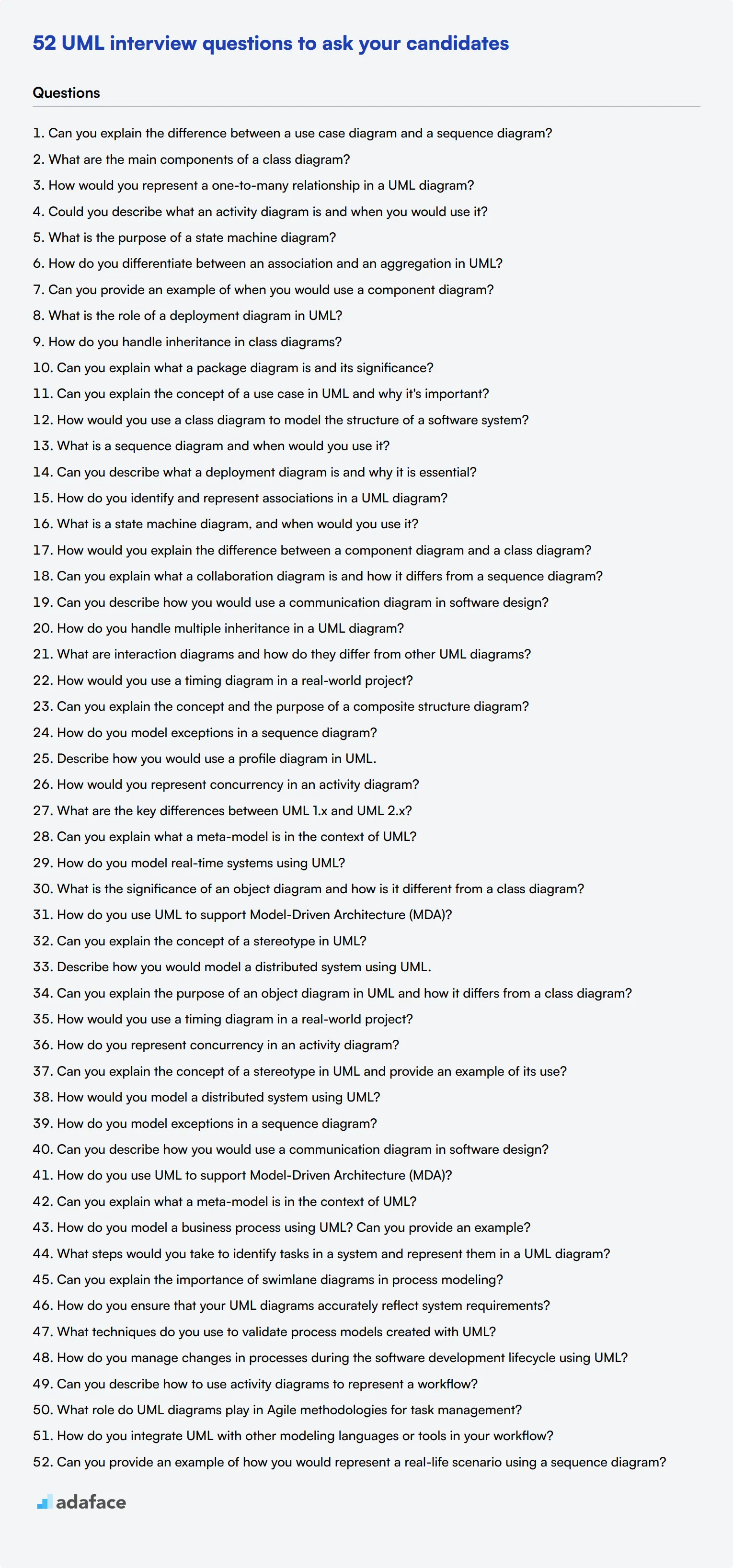Interviewing candidates for UML skills can be daunting, especially when it's crucial to identify those who can genuinely contribute to your team's success. This list of questions will help you gauge the depth of a candidate’s understanding and capability in Unified Modeling Language, much like knowing the importance of skills for developers.
This blog post will provide you with a comprehensive list of UML interview questions, categorized by different experience levels and specific focus areas. From common questions to more technical ones about processes and tasks, you will find what you need to evaluate potential hires effectively.
Using these questions, you can ensure your candidates have the necessary skills and knowledge to excel in UML-related roles. Additionally, to streamline your hiring process, consider using our UML Online Test before conducting interviews.
Table of contents
10 common UML interview questions to ask your candidates

To determine whether your applicants have the right skills to work with UML, ask them some of these common UML interview questions. These questions will help you evaluate their technical understanding and practical abilities.
- Can you explain the difference between a use case diagram and a sequence diagram?
- What are the main components of a class diagram?
- How would you represent a one-to-many relationship in a UML diagram?
- Could you describe what an activity diagram is and when you would use it?
- What is the purpose of a state machine diagram?
- How do you differentiate between an association and an aggregation in UML?
- Can you provide an example of when you would use a component diagram?
- What is the role of a deployment diagram in UML?
- How do you handle inheritance in class diagrams?
- Can you explain what a package diagram is and its significance?
8 UML interview questions and answers to evaluate junior designers
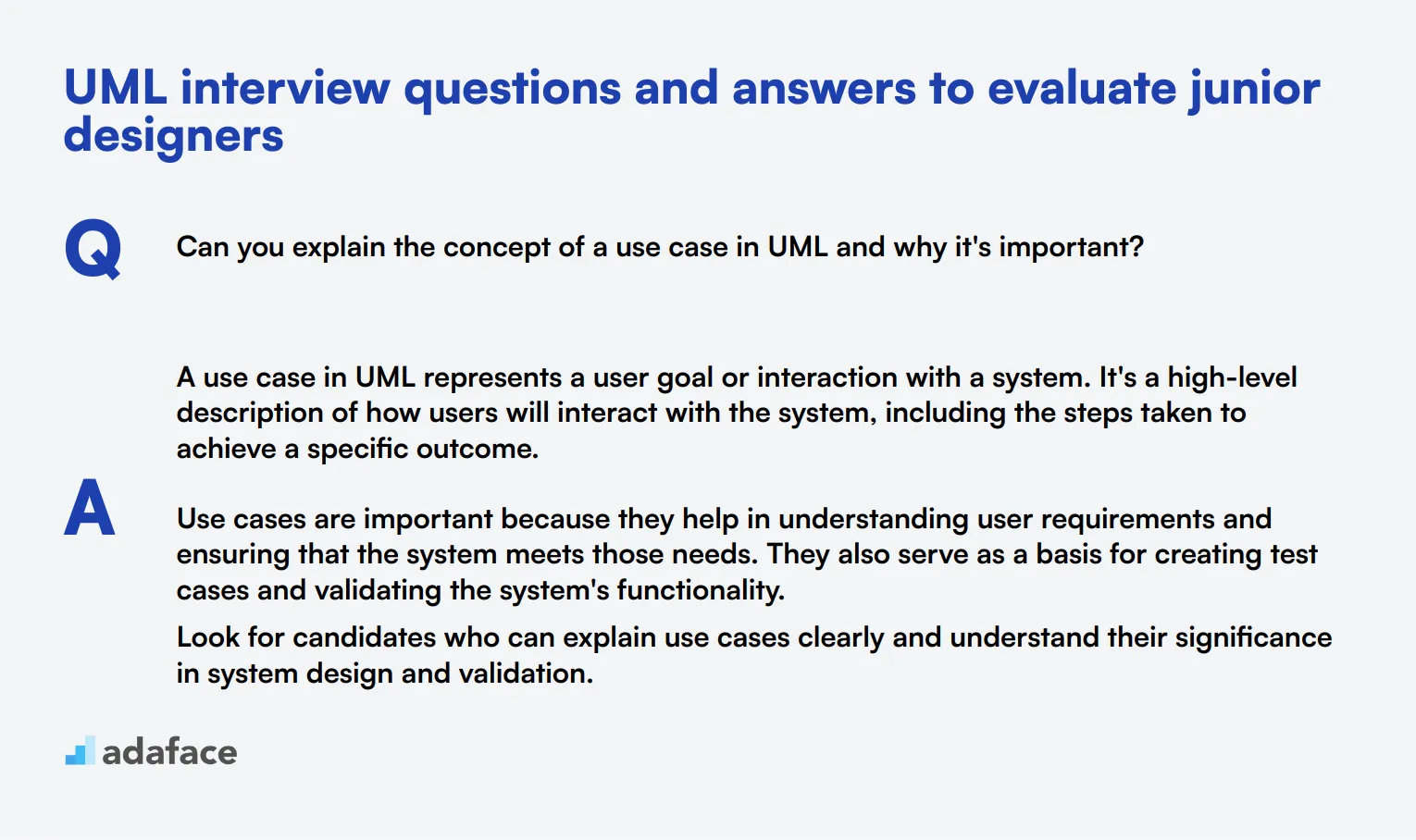
To evaluate junior designers' understanding of UML, use these targeted questions in your interviews. These questions will help you gauge their practical knowledge and their approach to using UML in real-world scenarios.
1. Can you explain the concept of a use case in UML and why it's important?
A use case in UML represents a user goal or interaction with a system. It's a high-level description of how users will interact with the system, including the steps taken to achieve a specific outcome.
Use cases are important because they help in understanding user requirements and ensuring that the system meets those needs. They also serve as a basis for creating test cases and validating the system's functionality.
Look for candidates who can explain use cases clearly and understand their significance in system design and validation.
2. How would you use a class diagram to model the structure of a software system?
A class diagram is used to model the static structure of a software system. It shows the system's classes, their attributes, methods, and the relationships among the classes.
Class diagrams help in visualizing the system's structure, understanding the relationships between different parts of the system, and ensuring that the design is logically sound.
Candidates should be able to explain how they would identify classes, define attributes and methods, and establish relationships like inheritance and associations.
3. What is a sequence diagram and when would you use it?
A sequence diagram in UML illustrates how objects interact in a particular scenario of a use case. It shows the sequence of messages exchanged between objects to carry out a specific function.
Sequence diagrams are useful for understanding the flow of control and data among objects. They help in identifying potential issues in the interaction logic and ensuring that the system's behavior aligns with user requirements.
Evaluate if the candidate understands how to represent object interactions and the importance of sequence diagrams in validating system behavior.
4. Can you describe what a deployment diagram is and why it is essential?
A deployment diagram represents the physical architecture of a system, showing how software components are deployed on hardware nodes. It includes nodes, artifacts, and the relationships between them.
Deployment diagrams are essential for understanding the system's infrastructure, ensuring that the physical deployment meets performance and reliability requirements, and planning resource allocation.
Look for candidates who can articulate the role of deployment diagrams in planning and optimizing the system's physical setup.
5. How do you identify and represent associations in a UML diagram?
Associations in UML represent relationships between classes. They are depicted as lines connecting classes, often labeled with the role names and multiplicities to indicate the nature of the relationship.
To identify associations, you need to understand how objects of different classes interact and relate to each other in the system. For example, a 'Customer' class might have an association with an 'Order' class indicating that customers place orders.
Ideal candidates should be able to identify relevant associations and accurately represent them with appropriate labels and multiplicities.
6. What is a state machine diagram, and when would you use it?
A state machine diagram in UML describes the states an object can be in and the transitions between those states based on events. It is used to model the dynamic behavior of a system.
State machine diagrams are particularly useful for modeling complex life cycles of objects, such as a 'Document' that can be in states like 'Draft', 'Reviewed', and 'Approved'.
Candidates should demonstrate an understanding of how to use state machine diagrams to model and manage the dynamic aspects of a system effectively.
7. How would you explain the difference between a component diagram and a class diagram?
A component diagram represents the high-level structure of a system by showing its components and their relationships. Components are larger units such as subsystems or modules with well-defined interfaces.
In contrast, a class diagram focuses on the detailed internal structure of the system by showing classes, attributes, methods, and relationships.
A strong candidate should articulate that component diagrams help in understanding system architecture, while class diagrams are used for detailed design and implementation.
8. Can you explain what a collaboration diagram is and how it differs from a sequence diagram?
A collaboration diagram, also known as a communication diagram, shows how objects interact to achieve a specific goal. It emphasizes the structural organization of objects and their interactions.
Unlike sequence diagrams, which focus on the order of messages, collaboration diagrams highlight the relationships and roles of objects in the interaction.
Look for candidates who can explain the purpose of both diagrams and know when to use each type based on the information they need to convey.
15 intermediate UML interview questions and answers to ask mid-tier designers
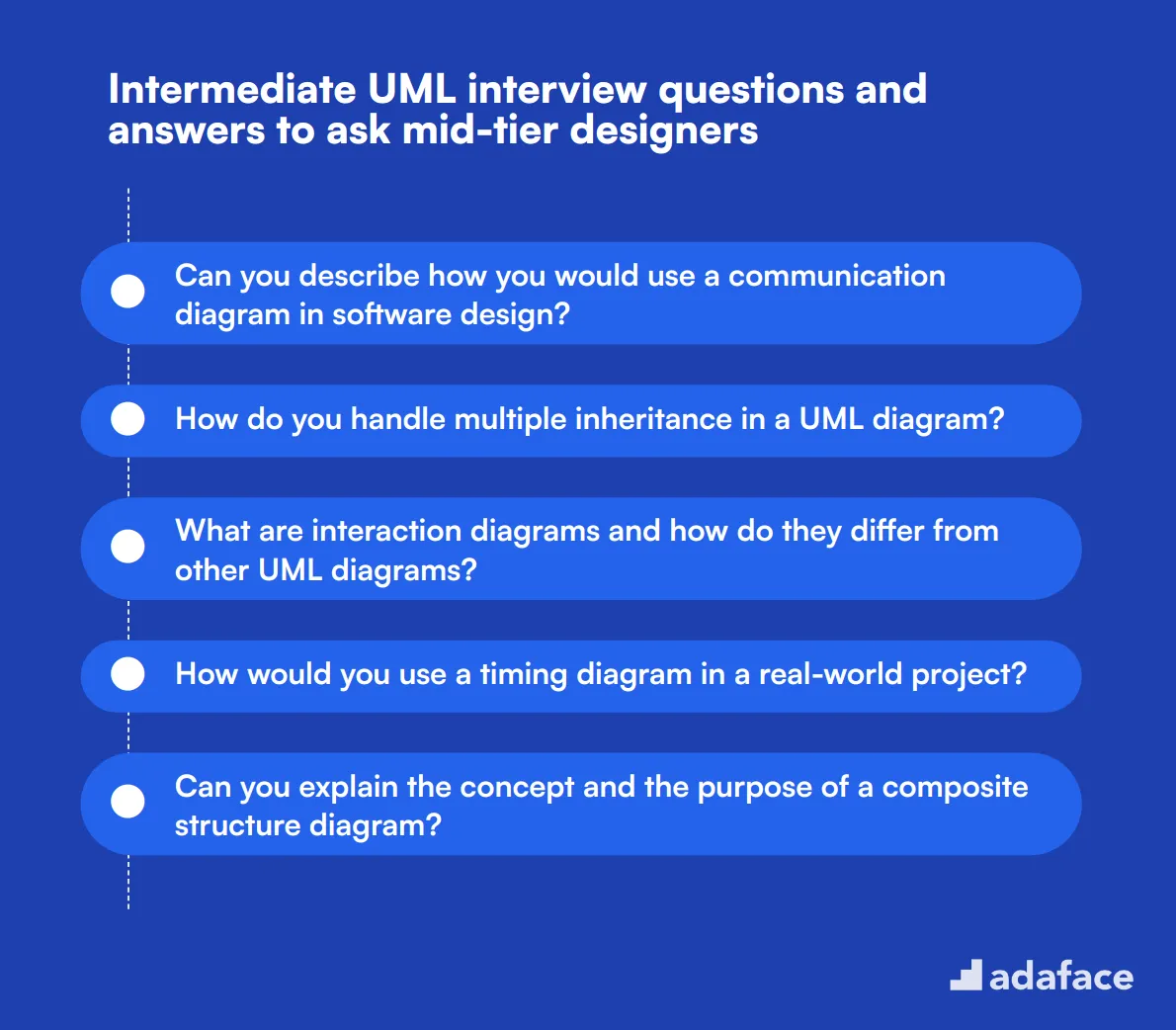
To effectively evaluate mid-tier designers' proficiency in UML, consider using these 15 intermediate questions. These questions are designed to gauge their ability to navigate more complex UML concepts and scenarios, ensuring they are well-equipped for roles detailed in this software engineer job description.
- Can you describe how you would use a communication diagram in software design?
- How do you handle multiple inheritance in a UML diagram?
- What are interaction diagrams and how do they differ from other UML diagrams?
- How would you use a timing diagram in a real-world project?
- Can you explain the concept and the purpose of a composite structure diagram?
- How do you model exceptions in a sequence diagram?
- Describe how you would use a profile diagram in UML.
- How would you represent concurrency in an activity diagram?
- What are the key differences between UML 1.x and UML 2.x?
- Can you explain what a meta-model is in the context of UML?
- How do you model real-time systems using UML?
- What is the significance of an object diagram and how is it different from a class diagram?
- How do you use UML to support Model-Driven Architecture (MDA)?
- Can you explain the concept of a stereotype in UML?
- Describe how you would model a distributed system using UML.
9 UML interview questions and answers related to diagrams

Ready to dive into the world of UML diagrams? These 9 interview questions will help you assess candidates' understanding of various UML diagrams and their practical applications. Use them to gauge how well applicants can visualize and communicate software designs through diagrams. Remember, the best answers will show both theoretical knowledge and real-world experience!
1. Can you explain the purpose of an object diagram in UML and how it differs from a class diagram?
An object diagram in UML represents a snapshot of the system at a particular moment, showing instances of classes and their relationships. Unlike class diagrams which show the static structure of a system, object diagrams depict the system's state at a specific point in time.
Object diagrams are useful for visualizing and validating complex relationships between objects, especially when dealing with complex data structures or when you need to show how a system looks at runtime.
Look for candidates who can clearly differentiate between class and object diagrams. They should emphasize that object diagrams show specific instances with actual data, while class diagrams show the blueprint or structure of the system. Strong candidates might also mention use cases, such as using object diagrams for testing or explaining complex scenarios to stakeholders.
2. How would you use a timing diagram in a real-world project?
Timing diagrams in UML are used to show the change in state or condition of object instances over time. They're particularly useful in real-time systems or when precise timing of interactions between objects is crucial.
In a real-world project, a timing diagram could be used to:
- Model the behavior of embedded systems, such as microcontrollers
- Analyze and optimize the performance of time-critical operations
- Visualize and debug timing-related issues in concurrent systems
- Specify timing constraints for hardware interfaces
Look for candidates who can provide concrete examples from their experience. Strong answers might include how they used timing diagrams to identify bottlenecks in system performance or to ensure that real-time constraints were met in a critical application.
3. How do you represent concurrency in an activity diagram?
Concurrency in activity diagrams is typically represented using fork and join nodes. A fork node splits the flow into multiple concurrent threads, while a join node synchronizes multiple threads.
To represent concurrency:
- Use a fork node (thick horizontal bar) to split the flow into multiple parallel activities.
- Show the concurrent activities in parallel lanes.
- Use a join node (another thick horizontal bar) to synchronize the parallel flows back into a single thread.
Candidates should be able to explain that this representation allows for modeling of parallel processes and helps in visualizing how different parts of a system can operate simultaneously. Look for answers that demonstrate an understanding of when concurrency is beneficial in system design and how it relates to real-world scenarios, such as multi-threaded applications or distributed systems.
4. Can you explain the concept of a stereotype in UML and provide an example of its use?
A stereotype in UML is a mechanism for extending or customizing the existing UML elements. It allows designers to create new types of modeling elements derived from existing ones, but with specific properties suitable for a particular problem domain or technology.
Stereotypes are typically represented by enclosing the stereotype name in guillemets (« »). For example:
- «interface» for Java interfaces
- «entity» for database entities in an ER diagram
- «controller» for MVC architecture components
- «boundary» for user interface elements
Look for candidates who can explain how stereotypes enhance the expressiveness of UML diagrams. Strong answers might include how they've used custom stereotypes to model domain-specific concepts or to align UML diagrams with particular software architectures or frameworks.
5. How would you model a distributed system using UML?
Modeling a distributed system using UML typically involves a combination of different diagram types to capture various aspects of the system. Key diagrams for this purpose include:
- Deployment diagrams: To show the physical architecture and distribution of system components across different nodes or machines.
- Component diagrams: To represent the high-level structure of the distributed components and their interfaces.
- Sequence diagrams: To illustrate the interactions between distributed components, including network communication.
- Activity diagrams: To model the flow of processes across different parts of the distributed system.
Look for candidates who emphasize the importance of clearly showing the boundaries between different system parts and the communication protocols used. Strong answers might include considerations for fault tolerance, scalability, and load balancing in the UML representation. Candidates should also mention the use of stereotypes or custom notations to represent distributed system-specific elements like message queues or load balancers.
6. How do you model exceptions in a sequence diagram?
Modeling exceptions in a sequence diagram involves showing the alternative flow that occurs when an exception is thrown. This can be done using the following elements:
- An alternative fragment (labeled 'alt') to show the normal flow and the exception flow.
- A return message with the exception type to indicate where the exception is thrown.
- Activation bars to show the exception handling process.
- Optional fragments to show cleanup or finalization steps.
Candidates should explain that the goal is to clearly illustrate both the normal execution path and what happens when an exception occurs. Look for answers that demonstrate an understanding of how exception handling affects the flow of control in a system. Strong candidates might also discuss how they use exception modeling to improve error handling in their designs or to communicate potential failure points to stakeholders.
7. Can you describe how you would use a communication diagram in software design?
Communication diagrams, also known as collaboration diagrams in UML 1.x, are used to show the interactions between objects or parts of the system, focusing on the relationships and links between them rather than the sequence of interactions.
In software design, communication diagrams can be used to:
- Visualize the overall structure of a system and how objects collaborate.
- Show complex interactions that are difficult to represent in sequence diagrams.
- Highlight the relationships and dependencies between different parts of the system.
- Model the static structure of a system while also showing some dynamic behavior.
Look for candidates who can explain the differences between communication diagrams and sequence diagrams, and when they prefer to use each. Strong answers might include examples of how they've used communication diagrams to simplify complex interactions or to provide a high-level view of system behavior to stakeholders.
8. How do you use UML to support Model-Driven Architecture (MDA)?
Model-Driven Architecture (MDA) is an approach to software design that uses UML models as the primary artifacts in the development process. To support MDA, UML is used in the following ways:
- Platform-Independent Models (PIMs): Create UML models that describe the system's functionality without reference to specific technologies.
- Platform-Specific Models (PSMs): Derive more detailed UML models from PIMs, incorporating platform-specific details.
- Transformation Rules: Define rules for transforming PIMs into PSMs and ultimately into code.
- Profiles and Stereotypes: Use UML extensibility mechanisms to tailor models for specific domains or platforms.
Look for candidates who understand the different levels of abstraction in MDA and how UML supports them. Strong answers might include experience with MDA tools, challenges in maintaining consistency between models, or strategies for ensuring that models remain the primary source of truth in the development process.
9. Can you explain what a meta-model is in the context of UML?
A meta-model in UML is essentially a model that defines the language for expressing other models. It describes the structure, semantics, and constraints for a family of models. In the context of UML, the meta-model defines the elements that can be used in UML diagrams and how they can be combined.
The UML meta-model serves several purposes:
- It provides a formal definition of the UML language.
- It ensures consistency across different UML tools and implementations.
- It allows for the extension of UML through profiles and stereotypes.
- It forms the basis for model transformation in Model-Driven Architecture approaches.
Look for candidates who can explain the relationship between models, meta-models, and meta-meta-models. Strong answers might include discussions on how understanding the meta-model helps in creating more precise and consistent UML diagrams, or how it relates to creating domain-specific modeling languages.
10 UML interview questions about processes and tasks
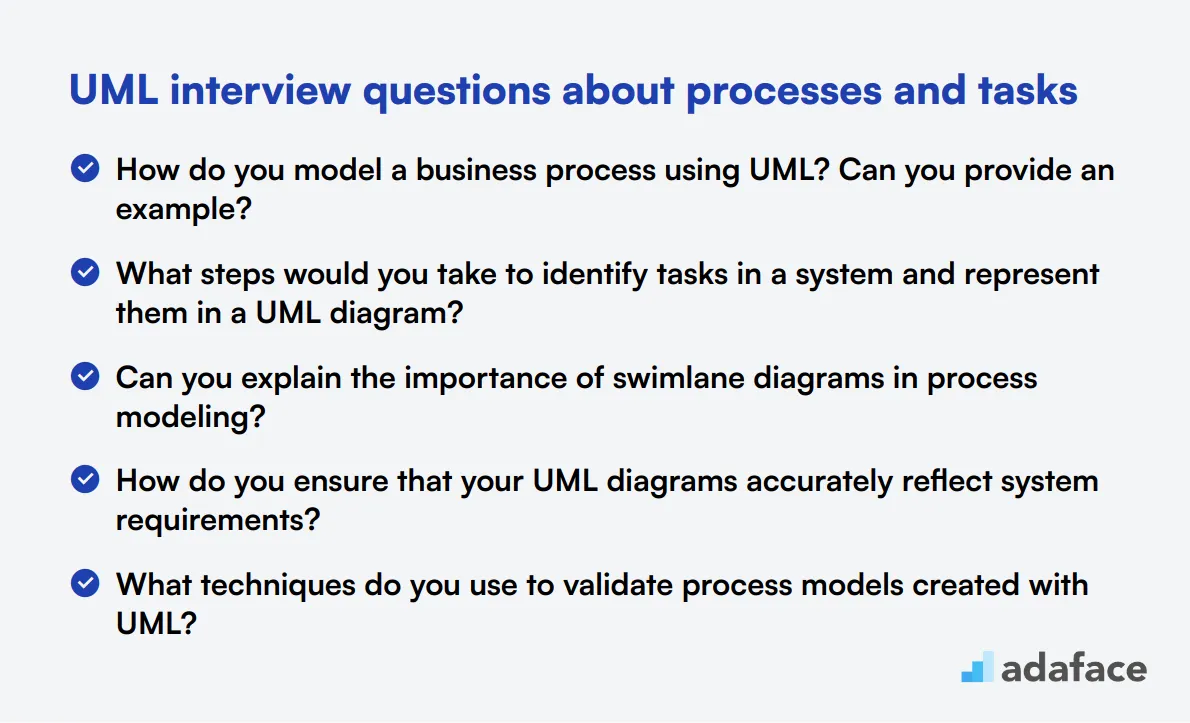
To ensure candidates can effectively manage processes in software projects, utilize this list of UML interview questions. These questions will help gauge their understanding of UML's role in modeling and executing complex tasks in your development team. For more detailed insights, check out our software engineer job description.
- How do you model a business process using UML? Can you provide an example?
- What steps would you take to identify tasks in a system and represent them in a UML diagram?
- Can you explain the importance of swimlane diagrams in process modeling?
- How do you ensure that your UML diagrams accurately reflect system requirements?
- What techniques do you use to validate process models created with UML?
- How do you manage changes in processes during the software development lifecycle using UML?
- Can you describe how to use activity diagrams to represent a workflow?
- What role do UML diagrams play in Agile methodologies for task management?
- How do you integrate UML with other modeling languages or tools in your workflow?
- Can you provide an example of how you would represent a real-life scenario using a sequence diagram?
Which UML skills should you evaluate during the interview phase?
While a single interview cannot provide a complete picture of a candidate's capabilities, it is essential to focus on specific UML skills that are foundational for a successful designer. Evaluating these skills will help you gauge their understanding and practical application of UML concepts effectively.
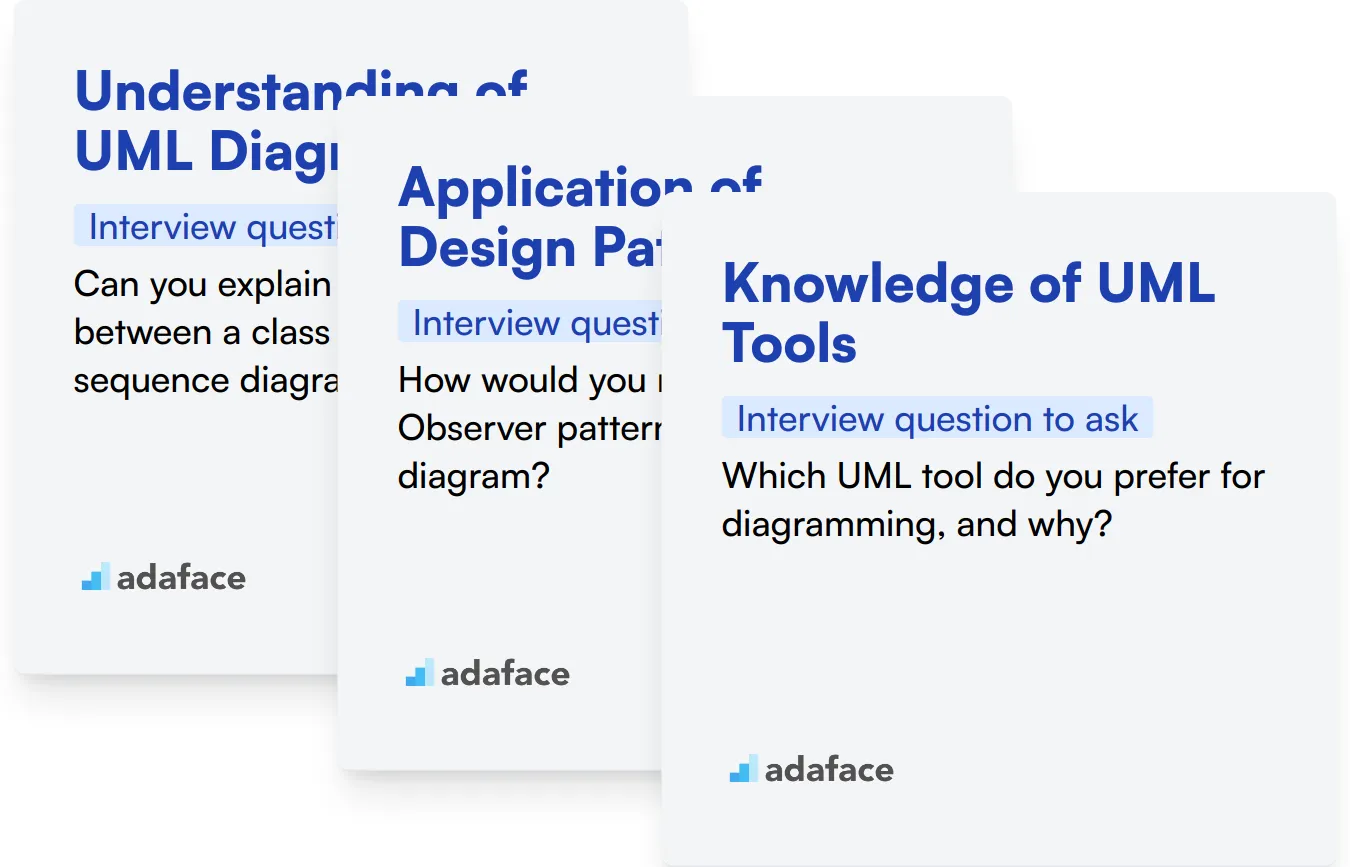
Understanding of UML Diagrams
You can implement an assessment test that includes relevant MCQs to filter candidates based on their understanding of UML diagrams. Consider utilizing our UML online test to streamline the screening process.
Additionally, asking targeted interview questions can help assess their knowledge. One effective question to consider is:
Can you explain the difference between a class diagram and a sequence diagram in UML?
When posing this question, look for clear explanations that demonstrate the candidate's understanding of the purpose and structure of each diagram. Candidates should be able to articulate how class diagrams focus on the static structure of the system, while sequence diagrams illustrate the dynamic interactions between objects.
Application of Design Patterns
An assessment test featuring multiple-choice questions about design patterns can help gauge this skill. You might find our UML online test useful for this purpose.
To further evaluate this skill, you could ask the following question:
How would you represent the Observer pattern in a UML diagram?
When asking this question, observe if the candidate can accurately describe the roles of subjects and observers and illustrate the relationships using appropriate UML notation. Their ability to visualize the pattern effectively indicates a strong grasp of both UML and design principles.
Knowledge of UML Tools
You can assess a candidate's tool proficiency through an assessment test that includes questions specific to UML tools and their functionality.
A targeted question you could ask is:
Which UML tool do you prefer for diagramming, and why?
When this question is posed, assess their reasoning behind the choice, including any specific features of the tool that enhance their design process. Candidates should highlight productivity, ease of use, or collaboration features as key factors.
Hire top talent with UML skills tests and the right interview questions
When hiring candidates with UML skills, it is important to accurately assess their expertise in this area. Without a proper evaluation, you risk bringing on board individuals who may not meet your expectations.
The most effective way to evaluate their UML capabilities is by using skill tests. Consider utilizing our UML online test to ensure candidates possess the necessary skills.
Once you administer this test, you'll be able to shortlist the best applicants for interviews. This rigorous process helps you focus on qualified candidates who can truly contribute to your team.
To get started, visit our test library and explore the various assessments available. Sign up today to streamline your hiring process and find the right talent!
UML Online Test
Download UML interview questions template in multiple formats
UML Interview Questions FAQs
UML stands for Unified Modeling Language. It's a standardized way to visualize the design of a system, helping teams understand, document, and communicate system architecture and processes.
UML diagrams provide a visual representation of system components and their interactions. They help in planning, designing, and communicating the architecture, reducing misunderstandings and improving efficiency.
Look for a clear understanding of UML concepts, the ability to explain and create different types of diagrams, and how they apply UML in real-world scenarios.
Ask them to create or interpret UML diagrams, explain their choice of diagrams for specific scenarios, and discuss how they've used UML in past projects.
Key UML diagrams include class diagrams, use case diagrams, sequence diagrams, activity diagrams, and state diagrams. Each serves a specific purpose in modeling system behavior and structure.
While not all developers use UML daily, having a basic understanding can be helpful for communicating design and architecture, especially in collaborative environments.

40 min skill tests.
No trick questions.
Accurate shortlisting.
We make it easy for you to find the best candidates in your pipeline with a 40 min skills test.
Try for freeRelated posts
Free resources




